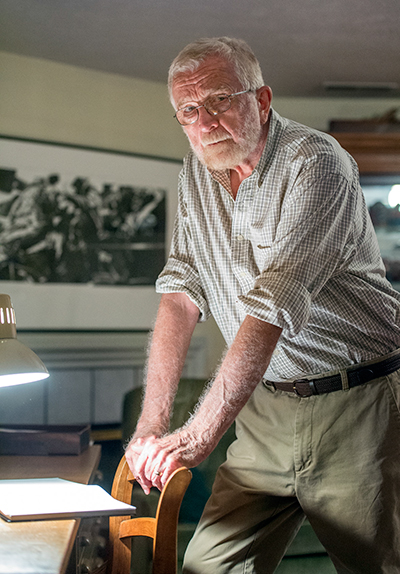|
Richard Myers, Filmmaker
2014 LIFETIME ACHIEVEMENT ARTIST PRIZE FOR VISUAL ARTS
His wife, Pat, whom he met in high school, was in this film entitled The Path. It was based on a dream about a group of people on a picnic. “That was when I truly got hooked on experimental film,” Richard recalls. In 1961, he earned his MA at KSU, and his film thesis launched his career as an independent filmmaker. He continued making films, all of which were shot in the Kent region, where he taught at a public school for a few years before becoming a Professor of Art and Cinematography at his alma mater. He taught until 1991. In his films, he cast family, friends and colleagues from KSU. His process entailed waking up from an intriguing dream, jotting notes about scenes, drawing sketches of striking images, and putting them all in a file, then typing his notes onto 3 x 5 cards. He would play around with the order of the cards and sometimes shuffle them randomly. Myers was inspired by his innovative heroes, the Surrealists and the Dadaists: filmmakers like Rene Clair, Bunuel, Dali, Leger, and Hans Richter of the Twenties; Eisenstein and Cocteau of the Thirties; and Bergman and Fellini of the Fifties and Sixties. He was also influenced by American independent filmmakers of the Sixties and Seventies, filmmakers like Maya Deren, Bruce Baillie, and Pat O’Neill. Richard made films that tell a story but not in a simple way. “Hollywood wants you to like their films, but I had other things in mind,” he says. “I didn’t care if people liked them. I was interested in what the films looked like, the images originating from black and white photography and the rhythm of the film.” Two of his works, Akran (1969) and Deathstyles (1971), garnered significant attention, including showings at the Whitney Museum of American Art in New York and numerous regional film festivals, along with a glowing Roger Ebert review after the first film’s world premier in Chicago: “Akran is a work of overpowering originality, forcing us to rethink our ideas about the film experience. In my opinion, it is the most influential film since Godard’s early work.” Paramount Pictures contacted Richard, asking to view the film. When he told them he didn’t think the film had any commercial potential, he was curtly informed that they would be the judge of that. Two weeks later, he received a letter confirming his assessment. “Richard is the real deal, an exceptionally talented filmmaker with a distinctive vision, who was one of the key experimental filmmakers in the country,” assesses John Ewing, director of the Cleveland Institute of Art’s Cinematheque and the Cleveland Museum of Art film series. Ewing remembers seeing many experimental filmmakers and their work that Richard brought to KSU as the Director of the Filmworks program, including Stan Brakhage, James Broughton, Shirley Clarke and Hollis Frampton. In turn, those avante-garde filmmakers would invite Richard to show his films wherever they were teaching. During the past 50 years, Myers has shown films and lectured at more than a hundred universities, colleges and film societies. Additionally, he’s received First Prize film festival awards at the Ann Arbor Film Festival, the Kenyon Film Festival and the Chicago International Film Festival. Among his numerous awards and grants, he has won two Guggenheim Fellowships, an American Film Institute Grant, a National Endowment for the Arts Independent Artist’s Grant and several Ohio Arts Council Grants for filmmaking. Due mostly to the exorbitant costs required to use real film, Richard made his last major movie in 1996, Monster Show, which melded his dreams with the Frankenstein, Dracula and Jekyll and Hyde stories and even paid homage to his childhood film. Then, in 2002, he made a full-length video, Marjory’s Diary, a portrait of his 94-year-old mother based on diaries she had kept as a young woman. “In the end, I made the films I wanted to make,” he says. “It was always a joy to get film back from the lab to see what you had captured, and then share it with viewers.” Myers’ films and DVD’s are available at his website: www.richardmyersfilms.com. |
